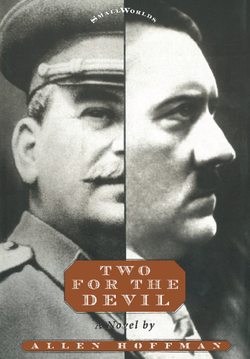Читать книгу Two for the Devil - Allen Hoffman - Страница 7
ОглавлениеTHE LETTER
FOR YEARS THE REBBETZIN, SHAYNA BASYA, DUTIFULLY placed Postum and Aunt Jemima pancakes before the rebbe in the morning, and Yaakov Moshe Finebaum dutifully consumed them. After breakfast, the rebbetzin placed pen and paper on the rebbe’s desk; but even though he spent long hours alone in his study, the rebbe never touched them. When she encouraged him to write to their daughter, Rachel Leah, in Russia, he would nod agreeably and explain, “When the time is right.”
There were moments when the rebbetzin thought the time might be right. In 1923, after Warren Harding died and Silent Cal Coolidge entered the White House, the rebbetzin noticed that the pen and paper had been used. But one morning, the rebbe pointed with disgust at a campaign picture in the St. Louis newspaper of Calvin Coolidge posing in an Indian warbonnet. In the background, his chauffeur and limousine waited to whisk him away. “An impostor, a fake,” the rebbe declared angrily and stalked into his study. The next morning, Shayna Basya again found the writing materials untouched.
They remained that way until 1927, when Charles A. Lindbergh made his historic solo flight across the Atlantic. “The Spirit of St. Louis,” the rebbe mused conspiratorily, savoring the name of the heroic aviator’s craft. “Our son-in-law, Hershel Shwartzman, could fly it back here for him,” he suggested, picking up the pen. The rebbetzin didn’t respond. As far as she knew, Grisha, their son-in-law, couldn’t pilot a plane. Even if he could, Lindbergh had flown solo; there wasn’t any room in the “Spirit of St. Louis” for Rachel Leah. It made no difference, however, for the rebbe suddenly ceased writing when the newspaper worshipfully referred to Lindbergh as the “Lone Eagle.” “A trayf bird, grasping impurity,” he pronounced, sadly shaking his head. Despairing of his ever writing to their daughter, Shayna Basya stopped providing him with pen and paper.
In 1936, Reb Zelig, the rebbe’s sexton, fell ill and died. On a steamy summer day, they buried him, and upon returning from the cemetery, the rebbetzin opened the icebox for a cool drink.
“Would you like something?”
“Yes,” he answered, sweat covering his smooth forehead in an unbroken watery film, as if he had just surfaced from a deep pool.
“What?” she asked.
“A pen and paper,” he demanded.
“Whatever for?” she asked.
“If I don’t write now, the letter won’t arrive before Rosh Hashanah,” he explained matter-of-factly.
The rebbetzin followed him into the study and presented him with pen and paper. “Thank you,” he said, and began writing at once.
Fifteen minutes later, she was sipping a cool glass of water at the kitchen table when the rebbe returned with the letter.
“That was quick,” she commented.
“Sixteen years, and you call it ‘quick,’ ” the rebbe said, slightly bemused.
“Would you like a drink?” she asked.
“A beer, please.”
She looked up in surprise. The rebbe had never shown any taste for the beverage.
“Yes, Prohibition is over,” he stated.
She placed the cool bottle on the table; at once a fine mist shrouded its dark surface. She pushed the letter away so it wouldn’t get wet.
“Thank you,” he said, but she didn’t answer.
She was staring down at the envelope addressed to her son-in-law. Prohibition had ended in St. Louis. The rebbetzin wondered how her daughter and son-in-law were welcoming Rosh Hashanah, the New Year, in Moscow in 1936.
